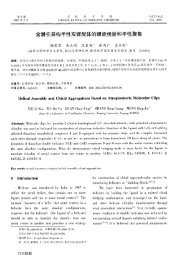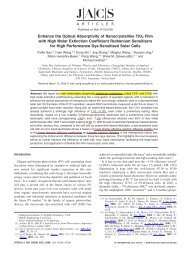Graphene Sheets from Graphitized Anthracite Coal: Preparation ...
Graphene Sheets from Graphitized Anthracite Coal: Preparation ...
Graphene Sheets from Graphitized Anthracite Coal: Preparation ...
You also want an ePaper? Increase the reach of your titles
YUMPU automatically turns print PDFs into web optimized ePapers that Google loves.
Energy & Fuels Article<br />
Figure 5. Electrochemical performance of coal-derived graphene sheets. (a) Cyclic voltammetry curves of GS with the scanning rates of 5 mV/s. (b)<br />
Specific capacitance against different discharge current density with 6 M KOH solution as an electrolyte. (c) Galvanostatic charge/discharge curves<br />
with the current density of 100 mA/g. (d) The cycling performance at a charge/discharge current of 100 mA/g.<br />
their precursors, meanwhile, the D bands at 1337 cm −1 become<br />
much more prominent, indicating the reduction in size of the<br />
in-plane sp 2 domains, possibly due to the extensive oxidation. 10<br />
The Raman spectra of the TX-NC-GS and TX-C-GS also<br />
contain both G and D bands (at 1590 and 1350 cm −1 ,<br />
respectively), however, with a decreased I D/I G intensity ratio<br />
compared to that in TX-NC-GO and TX-C-GO, which<br />
suggests an increase in the average size of the sp 2 domains<br />
and restoration of sp 2 network during reduction of GO in H 2<br />
discharge plasma process. 24,25 It should be noted that no<br />
obvious 2D bands can be observed in the Raman spectra of TX-<br />
NC-GS and TX-C-GS due to the disordered structure (defects,<br />
vacancies, or distortions of the sp 2 domains) caused by the use<br />
of strong acid (H 2SO 4) and strong oxidant (KMnO 4) during<br />
the oxidation stage. We can reasonably believe that it is very<br />
difficult for the graphene sheets to retrieve the graphitic<br />
structures through DBD plasma treatment. Compared with TX-<br />
NC-GS, the D band of TX-C-GS is weaker and wider, which<br />
suggests fewer structural defects in the latter than the former.<br />
As mentioned above, it can be concluded that the crystallinity<br />
of coal-derived carbon remarkably affects the structures and the<br />
properties of the graphene obtained <strong>from</strong> chemical exfoliation.<br />
26<br />
The oxygen-containing functional groups of TX-NC-GO,<br />
TX-NC-GS, as well as TX-C-GO and TX-C-GS were<br />
characterized by X-ray photoelectron spectroscopy (XPS).<br />
The high-resolution C1s spectrum of the TX-C-GO (Figure<br />
4a) and TX-NC-GO (Figure 4c) reveal that there are three<br />
main components arising <strong>from</strong> C�C (aromatic rings), C−O<br />
(alkoxy and epoxy), and C�O (carboxyl) groups. After DBD<br />
plasma treatment, carbon with different chemical valences<br />
remains for TX-NC-GS and TX-C-GS in XPS spectra; however,<br />
the peak intensities of them are much smaller than those in TX-<br />
5190<br />
NC-GO and TX-C-GO. As shown in Figure 4b,d, there are no<br />
O−C�O groups left in TX-NC-GS and TX-C-GS and the<br />
C�C bonds become dominant, while the peak intensities of<br />
C�O and C−O are obviously lower than that of TX-NC-GO<br />
and TX-C-GO, which indicates that most of the oxygencontaining<br />
groups in TX-NC-GO and TX-C-GO have been<br />
removed and the majority of the conjugated graphene networks<br />
are restored 27 by DBD plasma treatment for only 5 min. The<br />
residual oxygen-containing groups on the graphene sheets will<br />
benefit the wettability of the electrode in supercapacitor and<br />
metal or metal oxide catalyst grafting for heterogeneous<br />
catalysis. However, compared with TX-C-GS, it is worth noting<br />
that there are more significant C�O and C−O peaks left in the<br />
XPS spectrum of TX-NC-GS, which is consistent with the<br />
FTIR results.<br />
The electrochemical properties of these coal-derived<br />
graphene were measured in a 6 M KOH aqueous electrolyte<br />
with a three-electrode supercapacitor cell at room temperature<br />
by a CHI 660D electrochemical workstation. Figure 5a shows<br />
the CV measurement results of TX-NC-GS and TX-C-GS at<br />
the scanning rate of 5 mV/s. The CV curve of TX-C-GS<br />
exhibits a more typical rectangular shape than that of TX-NC-<br />
GS, indicating that the TX-C-GS has a better capacitive<br />
behavior and charge propagation at the surface of electrode<br />
following the electric double layer charging mechanism<br />
compared with TX-NC-GS. The specific capacitances of TX-<br />
NC-GS and TX-C-GS against the discharge current density are<br />
shown in Figure 5b, which was calculated <strong>from</strong> the<br />
galvanostatic charge and discharge curves at different current<br />
density, using the following equation 28<br />
C = IΔt/ mΔV dx.doi.org/10.1021/ef300919d | Energy Fuels 2012, 26, 5186−5192

















